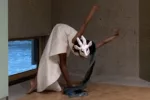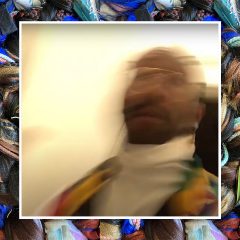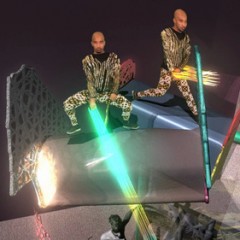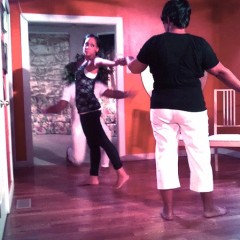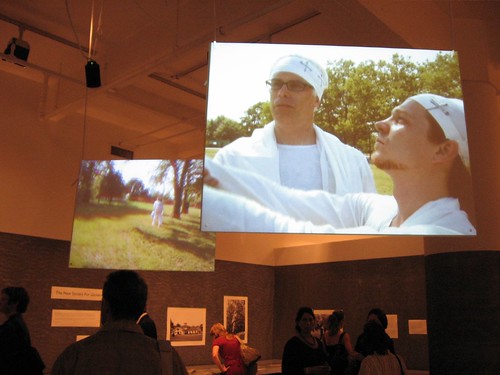
Lenore Malen, videos of the Harmonites in action, by Lenore Malen
New York’s CUE Art Foundation invites curators of substance to in turn invite artists to exhibit in its beautiful space. This month, Pepe Karmel invited my friend Lenore Malen, who installed two new video projections, new photographs and a long vitrine with historical and fictional artifacts, including precariously stacked little magnets, which with their invisible pull and their ramshackle tininess seem to push up the extremely large expanse of glass.
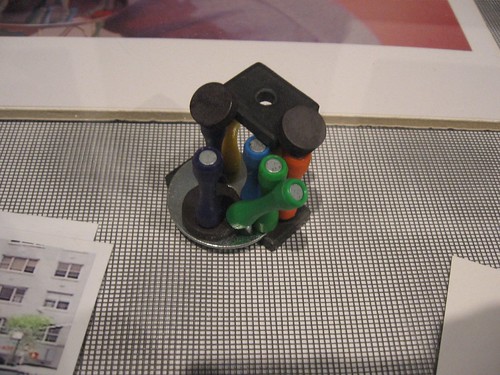
Magnetic power pillars holding up the glass top on the vitrine.
I went up to see the exhibit with Diane Burko; Lenore, Diane and I went to Skidmore College (class of ’66) and then we met up again when we were in graduate school at Penn (Burko in art, Malen in Art History and me in English Literature).
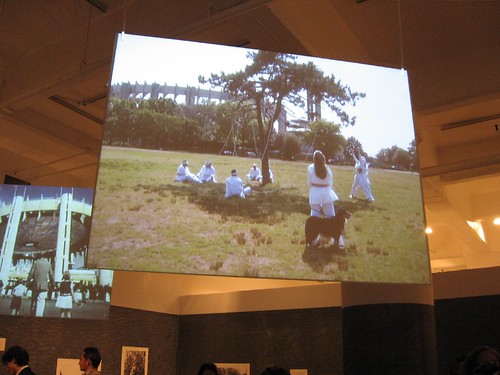
Malen spliced archival video footage of the New York World’s Fair (on rear screen) and NASA footage of U.S. astronauts with her own footage (front screen) of “members” of the New Society for Universal Harmony on the old World’s Fair grounds.
All Malen’s objects tell the tale–a blending of fiction and historical fact–of the New Society for Universal Harmony, her personal metaphor for the search for utopia and for spiritual and physical healing. Malen incorporates and undermines the idea of “animal magnetism” of Anton Franz Mesmer. The imagery of her friends undergoing quack cures and subjecting themselves to outlandish processes brings to mind Justine Kurland’s photographs of utopian nudist colonies, but adds a dose of sympathy and irony. Malen’s point is that these people aren’t really freaks. They are us, searching creatures that we are, willing to go to ridiculous means and buy into unprovable notions in hopes of finding a better life and an escape from the body’s mortality.
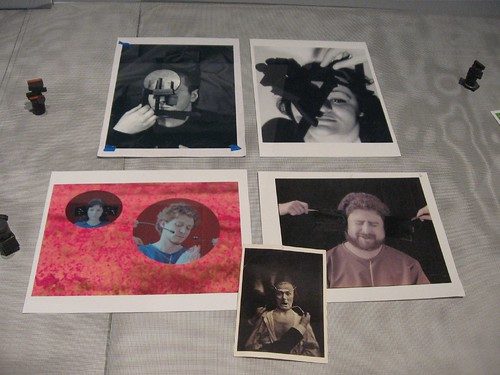
Continuing the exploration of ideas Malen explored in her exhibit at Slought Foundation (see post here) in 2004, the work continues to walk the line between the comic vulnerability of the human condition and our desire for a spiritual bond. I am reminded of all my friends (who may never talk to me again after this comment) going off to yoga retreats and seeking various shamanic cure-meisters, looking for a way to feel better–about themselves, their bodies, their lives, their place in the universe.
This is not work about juicy precious objects, although it mixes archival history from the work of Mesmer and other historical belief communities of his period with Malen’s staged archives from the present “revival.” It mixes concepts and culture, optimism and pessimism, and ultimately the slippery state of reality and reportage. Malen also has written a book, a sort of history of the New Harmony “movement,” based Mesmer’s own cure and belief community. The book was co-published by Slought Foundation and Granary Books.
Well, that was the reason for my spending Thursday in New York; more later on the rest of the stuff I saw.
And at the Fringe…
Then last night Murray and I went to Headlong Dance Theater’s Philadelphia Live Arts/Fringe presentation, Explanatorium, which felt not all that far-removed from what Malen was exploring. The participatory event, held in The Rotunda, was also about that desire to believe the inexplicable and believe in the power of unseen forces. By involving the audience in the performance, the split between observer and performer was challenged (but not erased–almost everyone in the audience was tentative with their change in role); and the idea that an audience becomes an ephemeral community was translated into the physical and spatial terms of dance. The final action in the performance of an audience snailing into a center and out (think the Greek folk dance misirlou) was a climax that brought that feeling of awe, of being a part of something larger than oneself, that all successful religions manage to create during a ceremony or service.
At the same time, there was a sense of irony and humor there that those of us who stand back from religion were sure to notice and take comfort in. I’m not so sure it was there for those who prefer to go with spiritual forces walking the land.
While I spent much of the “performance” trying to figure out whether I was even willing to go along with the most minor of requests–like pretending to reach to the ceiling or saying “go” to a small group so they knew when to reach–I did follow the crowd as requested. It just made me a little squirmy, having a life-long discomfort with obedience.
But my personal confusion was no worse than anyone else’s, as far as I could see. Others even sat it all out, watching from the sidelines. Only a couple of people in the audience really tried to be one with the company of performers.
I suppose my self-consciousness was an impediment to being swept along by the event, but in the end it did get me, and gave me something that I was happy to take away. Murray, who was less self-conscious than I–I know that because he didn’t notice when he wasn’t doing what everyone else was doing, nor did he seem to mind that–came away with pretty much the same reaction.
On the other hand, the Wooster Group’s great-looking Emperor Jones production, while quite interesting, I thought fell short (I was with Murray, Roberta and Steve, Andrea, and Maya). I should say at this point that this for me was another Skidmore connection; the play was directed by still another Skidmore classmate, Elizabeth LaCompte.
Most of our group, seemed delighted by the Butoh-like production of this Eugene O’Niell play. But Murray and I go to theater to be transported and be part of the group reaction. We were interested, we loved the dancing, the costumes, the use of the television screen, the witty propman choreography, but we weren’t transported. I spent a fair amount of the play wondering if the actor playing Jones was a woman and then, once I ascertained that was so, I wondered about why they might cast a woman in a man’s role; I entertained thoughts of George W. Bush as the emperor, and either Karl Rove or Richard B. Cheney as Smithers; I related the themes to Alfred Jarry’s Ubu Roi; I noodled with the magic properties of social power in general. But ultimately I wanted something more–that moment of awe when the ideas of the play become bigger than the play and my own feelings of seeing things a new way become one with the entire audience’s new vision.
I guess that’s my way of looking for connection.
This Emperor Jones production had a ceremonial quality that reminded me of a production of Medea I saw many years ago at the Public Theater. However, Medea moved me.


